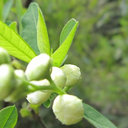Sonchus asper extract inhibits LPS-induced oxidative stress and pro-inflammatory cytokine production in RAW264.7 macrophages.
Cuvinte cheie
Abstract
OBJECTIVE
Sonchus asper is used extensively as an herbal anti-inflammatory for treatment of bronchitis, asthma, wounds, burns, and cough; however, further investigation is needed in order to understand the underlying mechanism. To determine its mechanism of action, we examined the effects of an ethyl acetate fraction (EAF) of S. asper on nitric oxide (NO) production and prostaglandin-E2 levels in lipopolysaccharide (LPS)-stimulated RAW264.7 macrophages.
METHODS
An in vitro culture of RAW264.7 macrophages was treated with LPS to induce inflammation.
RESULTS
Treatment with EAF resulted in significant suppression of oxidative stress in RAW264.7 macrophages as demonstrated by increased endogenous superoxide dismutase (SOD) activity and intracellular glutathione levels, decreased generation of reactive oxygen species and lipid peroxidation, and restoration of the mitochondrial membrane potential. To confirm its anti-inflammatory effects, analysis of expression of inducible NO synthase, cyclooxygenase-2, tumor necrosis factor-α, and the anti-inflammatory cytokines IL-1β and IL-6 was performed using semi-quantitative RT-PCR. EAF treatment resulted in significantly reduced dose-dependent expression of all of these factors, and enhanced expression of the antioxidants MnSOD and heme oxygenase-1. In addition, HPLC fingerprint results suggest that rutin, caffeic acid, and quercetin may be the active ingredients in EAF.
CONCLUSIONS
Taken together, findings of this study imply that the anti-inflammatory effect of EAF on LPS-stimulated RAW264.7 cells is mediated by suppression of oxidative stress.



